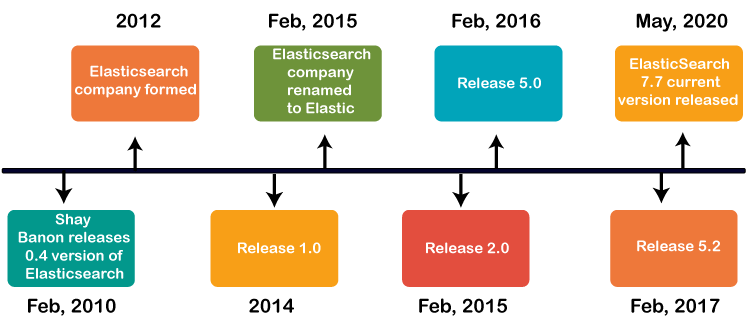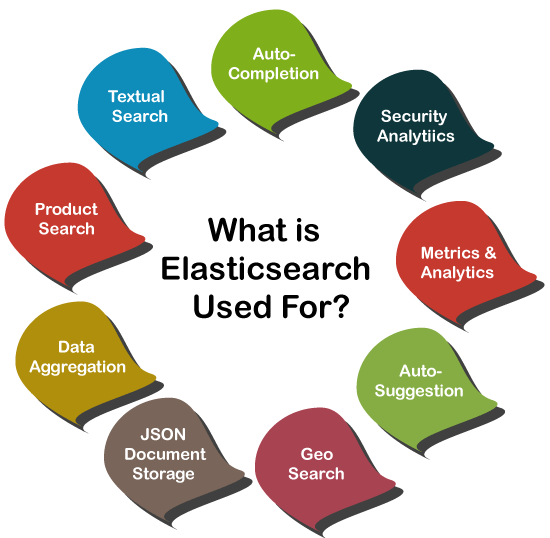Elasticsearch Tutorial

Elasticsearch tutorial provides basic and advanced concepts of the Elasticsearch database. This tutorial is basically designed for beginners as well as professionals who want to learn the basics and advance concepts of Elasticsearch. Elasticsearch is a NoSQL database, which is licensed under the Apache version 2.0. This tutorial contains several sections.
The guide we are giving in this tutorial is intended to provide knowledge on how to work with Elasticsearch. To work with Elasticsearch, you should have the basic knowledge of Java, web technology, and JSON.
What is Elasticsearch?
Elasticsearch is a NoSQL Database, which is developed in Java programming language. It is a real-time, distributed, and analysis engine that is designed for storing logs. It is a highly scalable document storage engine. Similar to the MongoDB, it stores the data in document format. It enables the users to execute the advanced queries to perform detailed analysis and store all data centrally.
Elasticsearch database is licensed under the Apache version 2.0 and based on Apache Lucene search engine. It is built-in RESTful APIs that help in fulfilling the request and responding to the request. It is an essential part of Elastic Stack or we can also say that it is a heart of Elastic Stack. It is open-source, which means that it is freely available. So, anyone can download it without paying any cost.
Elasticsearch mostly used in Single Page Application (SPM) projects. Many large organizations across the world use it. It supports full-text search that is completely document-based instead of schemas and tables. There are some more other search-based engines available, but they all are based on tables and schemas. A typical Elasticsearch document looks like this –
Why Elasticsearch?
With large datasets, relational database comparatively works slow and leads to slow search results from the database when queries are executed. RDBMS can be optimized but also brings a set of limitations like every field cannot be indexed and updating rows for heavily indexed tables is a long and annoying process.
Elasticsearch is a NoSQL distributed database, which is a solution for quick retrieval and storing data.
There are some other reasons for using Elasticsearch NoSQL database –
- Elasticsearch allows you to perform and combine various types of searches, like structured as well as unstructured. It also helps in working upon the data, which is based on geography as well as on matrix.
- You can retrieve the result from the data which you import in anyway you want. It is all based on structured query sets.
- It allows the users to ask the query anyway they want.
- Elasticsearch provides aggregations that help us to explore trends and patterns in our data.
- Elasticsearch takes care of both query and analysis on data.
- Elasticsearch database helps to complete the search query based on the previous searches automatically.
History of Elasticsearch
Elasticsearch was created by Shay Banon in February 2010. He released the first version 0.4 of Elasticsearch, but the company was formed in 2012. The current version of Elasticsearch is 7.7, which is released on May 13, 2020.

There are various changes has done in Elasticsearch, which are discussed below in detail-
| Year | Description |
|---|---|
| Feb 2010 | In February 2010, Shay Banon released the first version of Elasticsearch 0.4. |
| 2012 | In 2012, Elasticsearch company was formed. |
| Feb 2015 | In February 2014, Elasticsearch 1.0 was released. |
| Mar 2015 | Elasticsearch was renamed to Elastic on March 2015. |
| Oct 2015 | Another version of Elasticsearch 2.0 was released. |
| Oct 2016 | Elasticsearch 5.0 was released in October 2016. |
| Jan 2017 | Elasticsearch 5.2 was released in January 2017. |
| May 2020 | The current version of Elasticsearch 7.7 is released on May 13, 2020. |
Uses of Elasticsearch
After knowing that why Elasticsearch should be used? Let us now discuss the uses of Elasticsearch where it can be used –

Textual Search
Elasticsearch is useful for searching of pure text. It is mainly used where there is a lot of text, but we want to search the data with a specific phrase for the best match. In other words, we search for pure text.
Product Search
Elasticsearch uses properties and name, which offers faster product searches.
Geo Search
Elasticsearch is also used for geo-localized any product. For example – A search query like “All institutes that offer PGDM courses in India” can be used to display relevant information of institute by Elasticsearch, which offers PGDM courses across India.
Data Aggregation
Aggregation’s framework provides aggregated data based on search queries. It allows to group and performs calculations and statistics on your data using simple search queries. An aggregation can be
Auto-Suggest
Elasticsearch has an auto-suggest feature, which provides several suggestions to complete an incomplete query. This allows users to type a few characters, and then it will automatically display several suggestions to complete the query.
AutoComplete
Based on the previous searches, the Elasticsearch database helps to complete the search query automatically.
JSON Document Storage
Elasticsearch stores the data in the form of document. The documents are JSON objects that are stored in Elasticsearch index. In other words, the document is considered as a base unit of storage that can be indexed.
Metrics and Analysis
It analyses a dashboard that consists of several emails, logs, syslogs, and databases, which helps the businesses to understand their data and provides actionable insights.
Where can Elasticsearch be used?
- Elasticsearch (ES) is used as a storage and analysis tool for logs that are generated by disparate systems.
- It has a schema-less nature. So, it does not require to add a new column for adding a new column to the table. Elasticsearch allows adding a new column to incoming data in an index. It accommodates the new columns and makes them available for further operations.
- Elasticsearch allows extracting the metrics from the incoming connection in real-time. Therefore, it works well with the time-series analysis of data.
Prerequisites
To learn Elasticsearch, the learner should have a basic understanding of Java, web technologies, and JSON.
Audience
NoSQL database, which is Elasticsearch. It is designed for beginners and as well as professionals who want to enhance their skills in different areas.
Problem
We assure you that you will not find any discrepancies or problems in this tutorial. But in case, if you find any mistake, you can inform us by posting it in the contact form.
